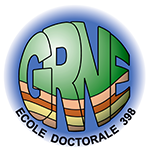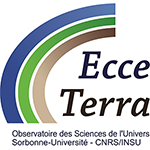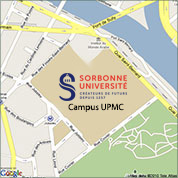Thomas Marion

EQUIPE : DYNAMIQUE ET ÉVOLUTION DES MARGES ET DES OROGÈNES
Chargée de recherche
Sorbonne Université - Campus Pierre et Marie Curie, Tour 46 - 00 2ème étage, Bureau 203
Téléphone : (33) 1 44 27 52 43
E-mail : marion.thomas@sorbonne-universite.fr
Thèmes de recherche
http://marionthomas.weebly.com/ - Géodesie, observation de terrain et Modélisation numérique du cycle sismique
Bibliographie
Soumis ou en préparation
J. Jara, L. Bruhat, M. Y. Thomas, S. Antoine, K. Okubo, E. Rougier, A. J. Rosakis, C. G. Sammis, Y. Klinger, R. Jolivet, H. S. Bhat, under review in Proceedings of the Royal Society A. Signature of transition to supershear rupture speed in coseismic off-fault damage zone.
S. A. M. den Hartog, M. Y. Thomas, and D. R. Faulkner, under review in Journal of Geophysical Research-Solid Earth. Do laboratory friction parameters compare with observed fault slip and geodetically derived friction parameters? Insights from the Longitudinal Valley Fault, Taiwan. # 2021JB022390
M. Y. Thomas, and H. S. Bhat (in preparation). Combined Effect of Off-Fault damage and Fault Roughness on Earthquake Rupture Dynamics and Ground Motion.
Evalués par des pairs:
A. Canitano, M. Godano, and M. Y. Thomas, 2021. Inherited state of stress as a key factor controlling slip and slip mode: inference from the study of a slow slip event in the Longitudinal Valley, Taiwan, Geophysical Research Letters, v. 48. doi: 10.1029/2020GL090278
J. D. B., Dianala, R. Jolivet, M. Y. Thomas, Y. Fukushima, B. Parsons, and R. Walker, 2020. The relationship between seismic and aseismic slip on the Philippine Fault on Leyte Island: Bayesian modeling of fault slip and geothermal subsidence, Journal of Geophysical Research: Solid Earth, v. 125, p2169-9313. doi: 10.1029/2020JB020052
M. Y. Thomas, and H. S. Bhat, 2018. Dynamic Evolution Of Off-Fault Medium During An Earthquake: A Micromechanics Based Model, Geophysical Journal International, v. 214, p1267-1280. doi: 10.1093/gji/ggy129
Y. Zhou, M. Y. Thomas, B. Parsons, R. T. Walker, 2018. Time-dependent postseismic slip following the 1978 Mw 7.3 Tabas- e-Golshan, Iran earthquake revealed by over 20 years of ESA InSAR observations, Earth and Planetary Science Letters, v. 483, p. 64-75. doi: 10.1016/j.epsl.2017.12.005
M. Y. Thomas, H. S. Bhat, and Y. Klinger, 2017b. Effect of Brittle off-fault Damage on Earthquake Rupture Dynamics, AGU monograph on “Fault Zone Dynamic Processes: Evolution of Fault Properties During Seismic Rupture », v. 227, p. 255-280. doi: 10.1002/9781119156895.ch14
M. Y. Thomas, J.-P. Avouac, and N. Lapusta, 2017a. Rate-and-state friction properties of the Longitudinal Valley Fault from kinematic and dynamic modeling of seismic and aseismic slip, Journal of Geophysical Research-solid Earth, v. 122, p. 3115–3137. doi:10.1002/2016JB013615
M. Y. Thomas, N. Lapusta, H. Noda, H. and J.-P. Avouac, 2014c. Quasi-dynamic versus fully-dynamic simulations of earthquakes and aseismic slip with and without enhanced coseismic weakening, Journal of Geophysical Research-solid Earth, v. 119, p. 1986-2004. 10.1002/2013JB010615
M. Y. Thomas, J.-P. Avouac, J.-P. Gratier, and J.-C. Lee, 2014b. Lithological control on the deformation mechanism and the mode of fault slip on the Longitudinal Valley Fault, Taiwan, Tectonophysics, v. 632, p. 48–63. doi: 10.1016/j.tecto.2014.05.038
M. Y. Thomas, J.-P. Avouac, J. Champenois, J.-C. Lee, and L.-C. Kuo, 2014a. Spatiotemporal evolution of seismic and aseismic slip on the Longitudinal Valley Fault, Taiwan, Journal of Geophysical Research-solid Earth, v. 119, p. 5114-5139. doi: 10.1002/2013JB010603
T. Ader, J.-P. Avouac, J. Liu-Zeng, H. Lyon-Caen, L. Bollinger, J. Galetzka, J. Genrich, M. Thomas, K. Chanard, S. N. Sapkota, P. L. Shrestha, S. Rajaure, D. Lin, and M. Flouzat, 2012. Convergence rate across the Nepal Himalaya and interseismic coupling on the Main Himalayan Thrust, implications for seismic hazard, Journal of Geophysical Research-Solid Earth, v 117, p. B04403. doi: 10.1029/2011JB009071
C. Hamelin, L. Dosso, B. B. Hanan, M. Moreira, A. P. Kositsky, and M. Y. Thomas, 2011. Geochemical portray of the Pacific Ridge: New isotopic data and statistical techniques, Earth and Planetary Science Letters, v. 302, p. 154-162. doi: 10.1016/j.epsl.2010.12.007
Livres & Volumes
M. Y. Thomas, and H. S. Bhat (in prep.) Loi de friction et modelisation numerique du cycle sismique, Ouvrage ISTE on “Le cycle Sismique »
M. Y. Thomas, H. S. Bhat , and T. Mitchell (Eds.), 2017. Fault Zone Dynamic Processes: Evolution of Fault Properties During Seismic Rupture, AGU monograph
Enseignements
2020 UE Seismo-tectonics – ENS
classe de Master 1 sur la friction, la mécanique fracture et la modélisation du cycle sismique
2018-20 UE MecaLith – Sorbonne Université
classe de Master 2 sur la friction et la mécanique fracture
Responsabilites
En charge des séminaires de l’ISTeP avec Damien Do Couto
Projets
L’objectif de mes travaux de recherche est de mieux contraindre le comportement constitutif des zones de faille afin d’améliorer l’estimation de l’aléa sismique. Pour répondre à cette question j’applique une approche pluridisciplinaire qui combine l’observation géologique, l’étude microstructurale, l’analyse géodésique du champ de déformation, l’inversion cinématique du déplacement sur les failles, la modélisation numérique du cycle sismique et la micromécanique. Ces méthodes complémentaires nous permettent de mieux caractériser les propriétés mécaniques des failles et de comprendre leurs relations avec la déformation observée.
Mon travail se base principalement sur l’étude des failles actives présentant des variations spatio-temporelles du mode de glissement, que ce soit en domaine continentale ou le long des zones de subduction, et sur la modélisation mécanique du déplacement sur les failles. Je m’intéresse également aux failles exhumées qui nous renseignent sur les processus mécaniques accommodant la déformation dans les zones de failles.
http://marionthomas.weebly.com/
Parcours
California Institute of Technology, Tectonics Observatory, Pasadena, CA, USA
2013, Doctor in Philosphy, major in Geology
California Institute of Technology, Tectonics Observatory, Pasadena, CA, USA
2011, Master of Science, major in Geology
nstitut Universitaire Européen de la Mer (IUEM), Plouzané, France
2007, Master de Géosciences, spécialité Géophysique et Géodynamique
Université de Bretagne Occidentale (UBO), Brest, France
2005, Licence de Géosciences
Lycée Brizeux, Quimper, France
2002, Classe Préparatoire de Physique Chimie Science de l’Ingénieur (PCSI)
Activités techniques
Divers
Egalement dans la rubrique
Chiffres clés (Mars 2025)
L'ISTeP comprend 131 membres dont :
Permanents (66)
- Professeurs : 17 (+2 PAST)
- Maîtres de conférence : 26
- Directeurs de recherche CNRS : 1
- Chargés de recherche CNRS : 1
- ITA : 19
Personnels non permanents (65)
- Collaborateurs bénévoles / émérites : 17
- Chaire de professeur junior : 1
- Enseignants-chercheurs contractuel : 2
- 1 MCF accueil en délégation
- ATER et Post-Docs : 9
- Doctorants : 32
- ITA-BIATSS : 3





